![]()
Images of my Wisconsin Trip to Hunt for Meteorites
Search for Chondrites - from the April 14th fireball and fall of meteorites in Grant and Iowa County in Wisconsin.
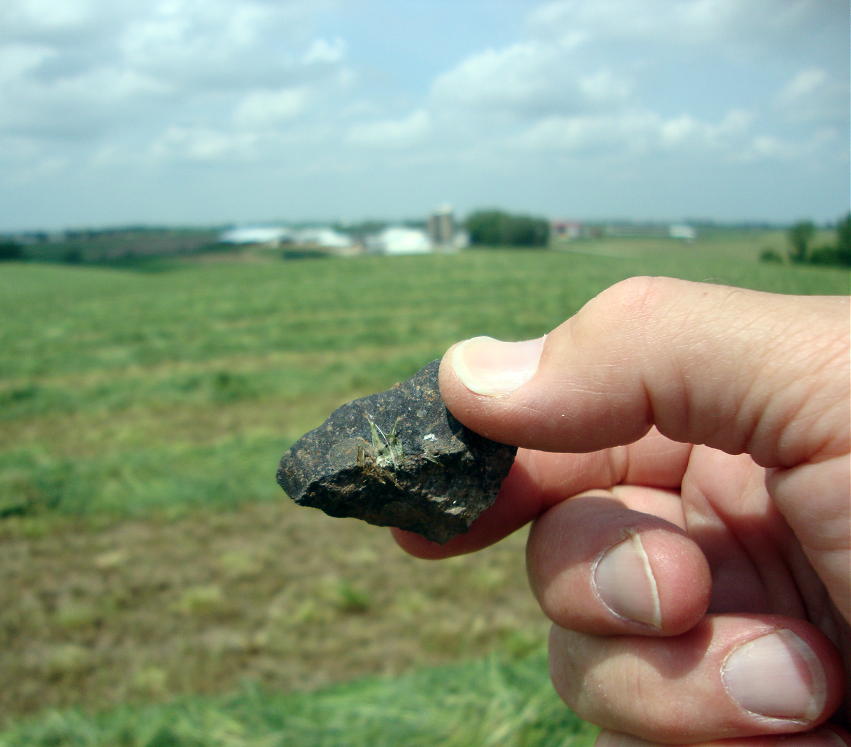
Holding my "Wisconsin" find for the first time.
View is of the find location looking in the direction of the property owners farm,
which is also looking "up the trend" of the strewn field.
Well, the title says it all. This month's installment of Bob's Findings will be just a "photo album" of images that I took during my mid-May stay in Wisconsin where I hunted for those chondritic stones that fell from the April 14th 2010 Fireball. And as of the writing of this article, the classification and the approved name for this meteorite have, yet, to be announced by the Nomenclature Committee of the Meteoritical Society. [See "UPDATE" below] There has been a lot of speculation as to what will be the approved name for this meteorite fall. If I were to speculate, I would say that the Nomenclature Committee may be delaying their announcement because they may be in the middle of developing a new process or set of guidelines for the naming and classification of falls. In fact, what may be percieved as a "delay" may only be the result of some recent past falls having been very quickly classified and named. Possibly, in an attempt to avoid any future criticism, the Committee may be taking a slower approach in determining a classification and determining a proper name, given that falls, such as this one, can produce strewn fields that can cover an area that would include several counties, or even several states. The Committee may simply be waiting to see what will eventually be the full extent of this Wisconsin strewn field.
[UPDATE: A name for the "Wisconsin Meteorite" has been approved by the Nomenclature Committee of the Meteoritical Society: Mifflin (L5 S1 W0) as per 2010-09-09 Met. Bulletin Database]
And to that end, trying to extend the limits of this strewn field, was what prompted me to go to Wisconsin. Even though I would arrive in Wisconsin a full month after the fall, and after many dozens of meteorite hunters had already come and gone, I was greatly encouraged by the results of Rob Matson's ongoing study of the NOAA-NWS Doppler radar weather data that there was a very good chance that more meteorites could be found by expanding the search area. In fact, while I was in Wisconsin, it was announced that Michael Cottingham's 105 gram find had the effect of extending the known strewn field 3.25 miles farther down-trend to the southeast.
Upon my arrival in Wisconsin, I first went to the area that is between Mineral Point and Darlington, and immediately started my search in an area that was actually in Lafayette County! Also during that first week, I tried to extend the NW end of the known strewn field by searching areas that were west of Montfort and had the same Zip Code as Clifton, WI.
After about a weeks time into my searching, I noticed that the farmers were starting to cut their "grass" (alfalfa fields). This had the effect of exposing new surfaces in fields that had not been hunted, yet. Now the new push was to find these fields and get permission from the farmers to hunt on their property. While searching in these fields it was educational to see how labor-intensive was the farmers work of cutting and "baling hay". Depending upon which method of "baling" was used, the process could take over a week for each field to be cut, raked, chopped/bailed, and fertilized. This could result in the farmer having to drive their tractors and equipment during this "baling process" a total of 3 or 4 times over every square meter of their hay fields. Even in fields that weren't getting plowed, the chance that a meteorite stone would get driven-over and pushed into the ground was very high.
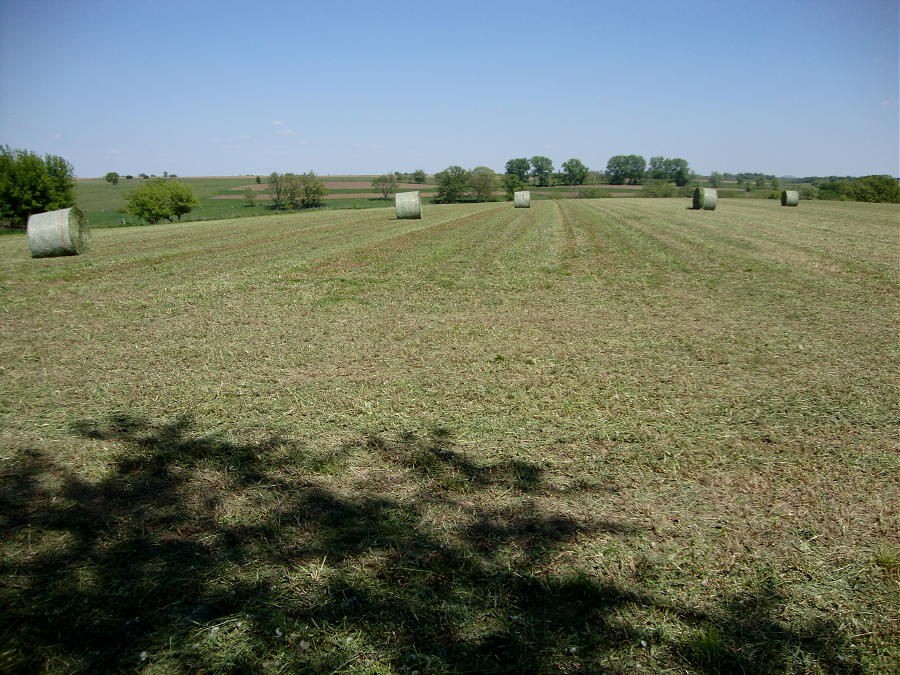
This style of making bales of hay results in too much waste and the alfalfa leaf litter ends up covering too much of the ground. It was easier searching the ground right after the grass was cut and put into narrow rows, but before it was allowed to dry, prior to being rolled into these bales. Of course, these rows of cut grass would cover a portion of the field, but a good 2/3rd could still be effectively searched.
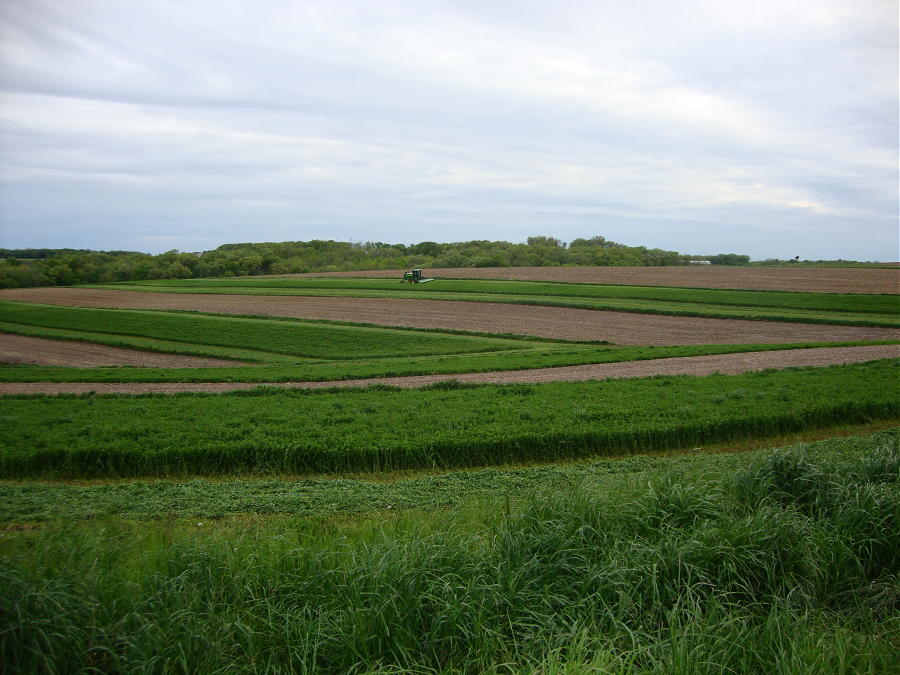
Another farm cutting another field of "grass". This cut grass was made into rectangular bales. This method of baling grass leaves little litter behind on the ground, effectively leaving the ground more bare and easier to search.
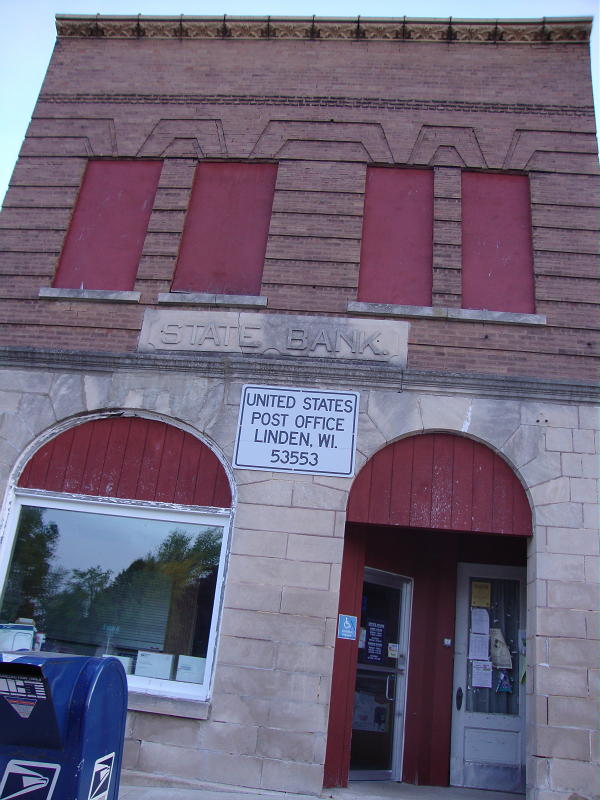
The Linden Post Office. This one is located closest to the main mass (as of this writing).
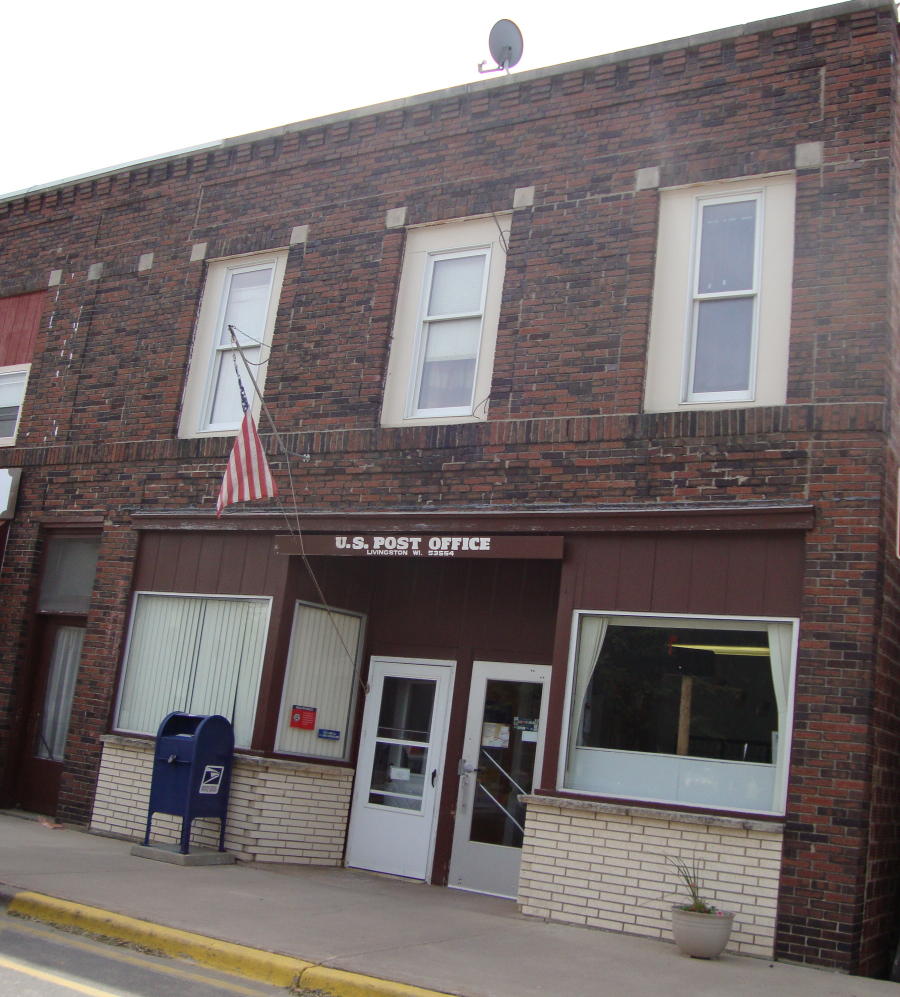
The Livingston Post Office. This one is located closest to the location where the first stone from this fall was recovered.
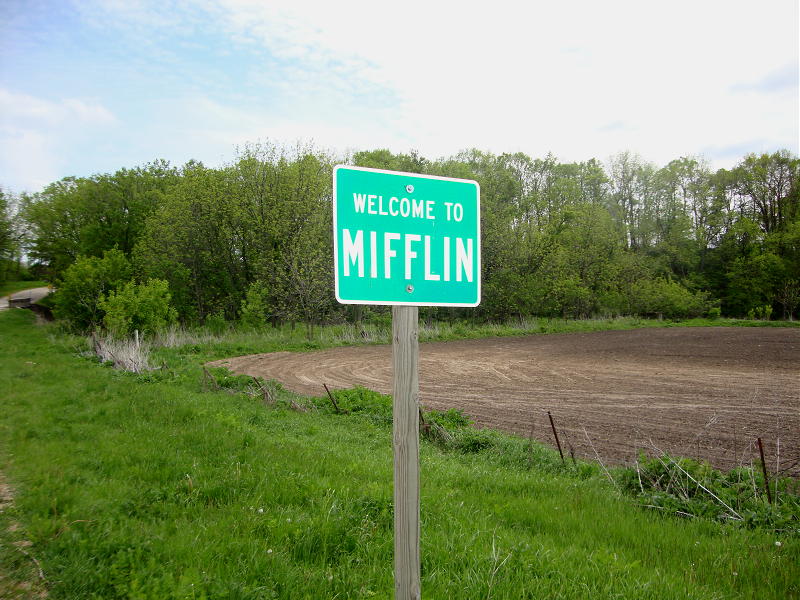
There is no post office in the town of Mifflin, but this village is located closest to the middle of the strewn field (as of this writing). [The NomCom opted to name this meteorite fall after this village.]
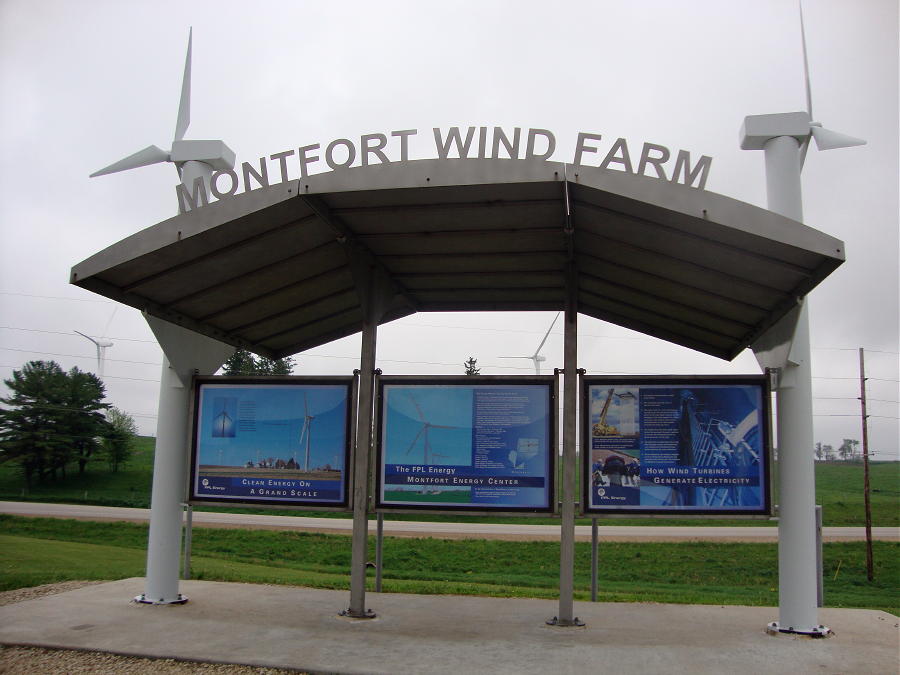
The northwest end of the strewn field is close to the town of Montfort.
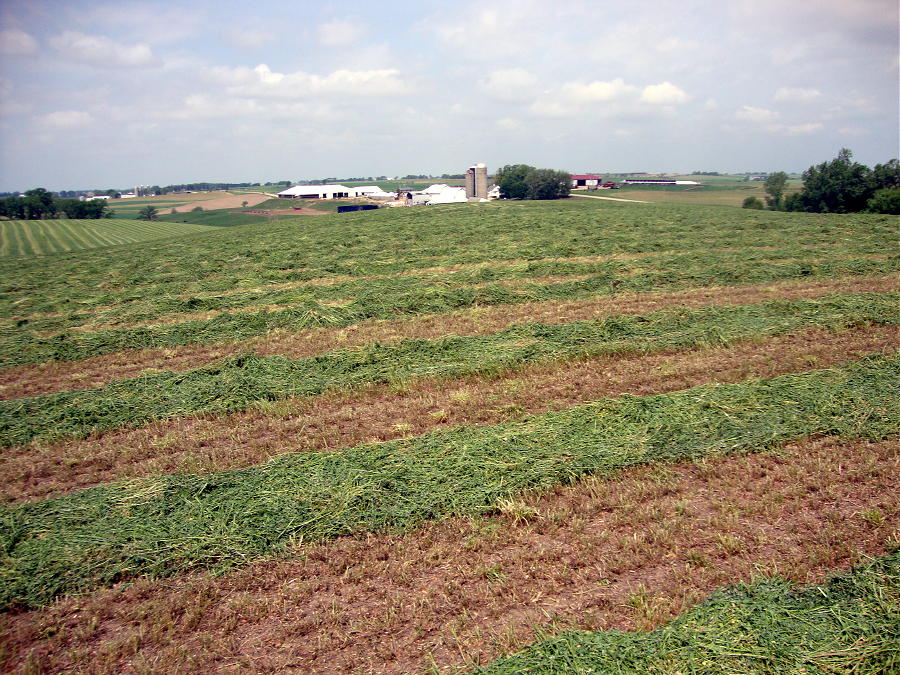
Less than an hour before I made my find, I took these two images (of what I calculated to be) on the trend line, with this image being a view up-trend in the strewn field, and the next image being a view down-trend. Now, compare this image with my in-situ image at the beginning of this article. And now, compare the next two images...
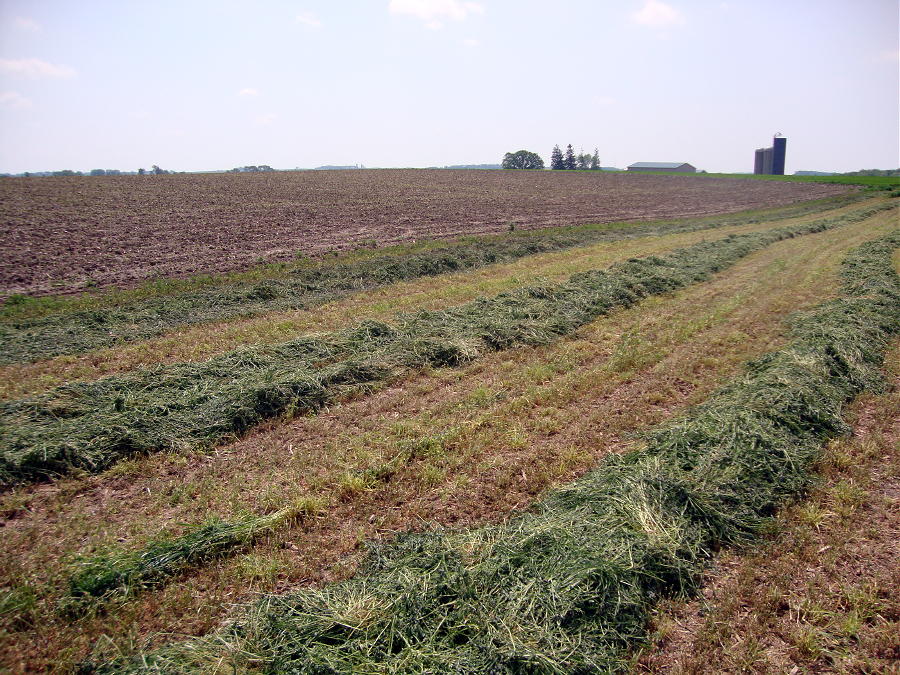
And this is a view in the opposite direction, down the trend line. Now, compare this image with my in-situ image below.
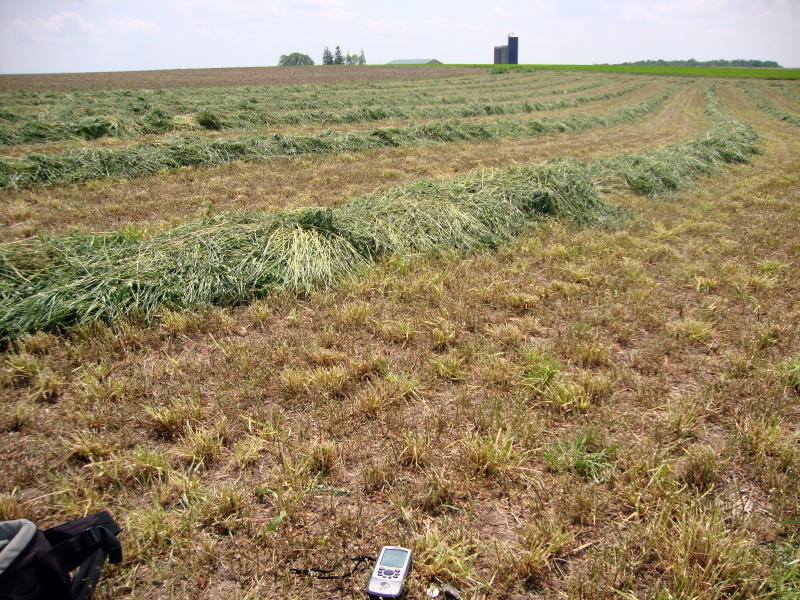
An in-situ image of my meteorite find, looking down the trend line. It appears that this find was made right on the trend line. Apparently my trend-calculations were accurate.
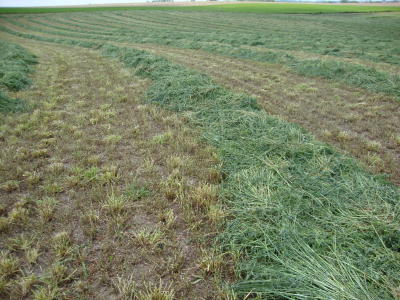
This image is actually an in-situ image of my find.
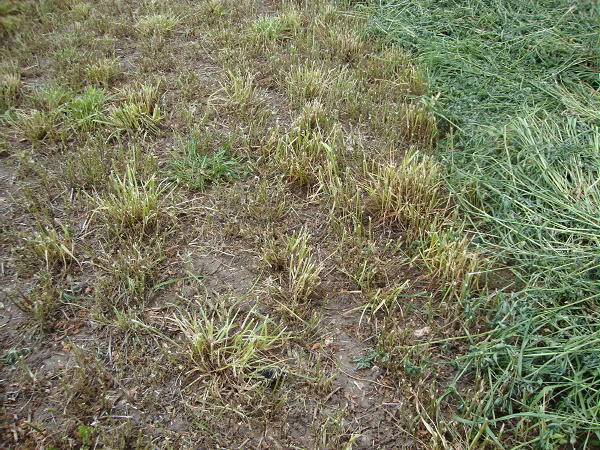
Now that we are closer to the stone, it is a little more visible.
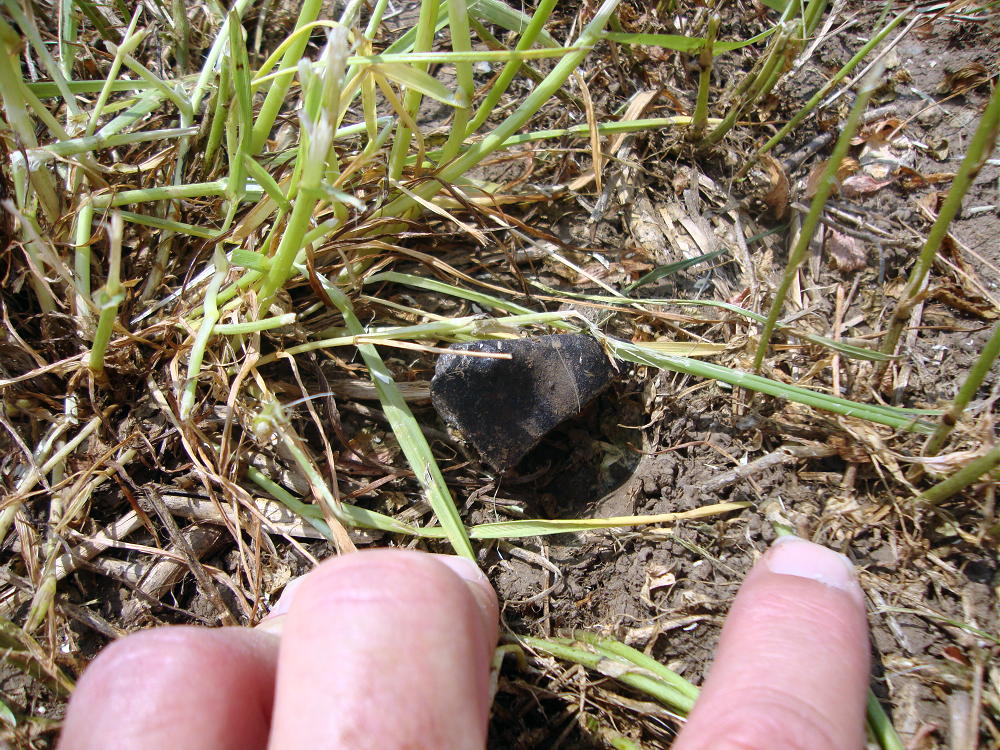
After I held-down the blades of grass with my hand, I finally realized that what I was looking at all this time was an actual meteorite.
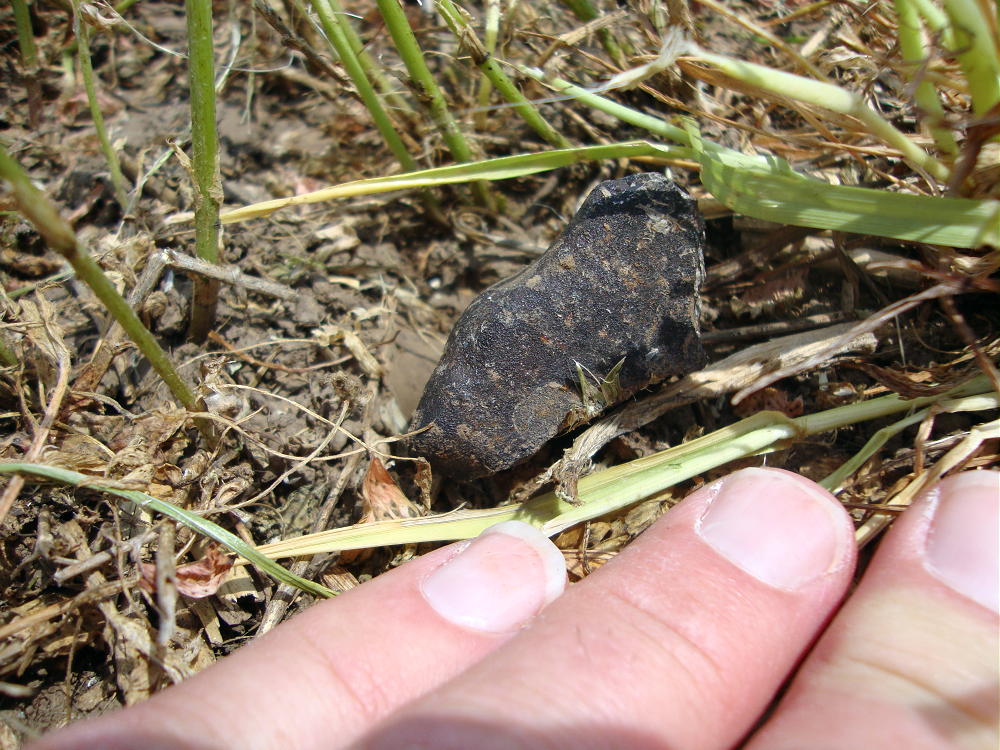
And this is what I saw. Confirmed! It is a meteorite.
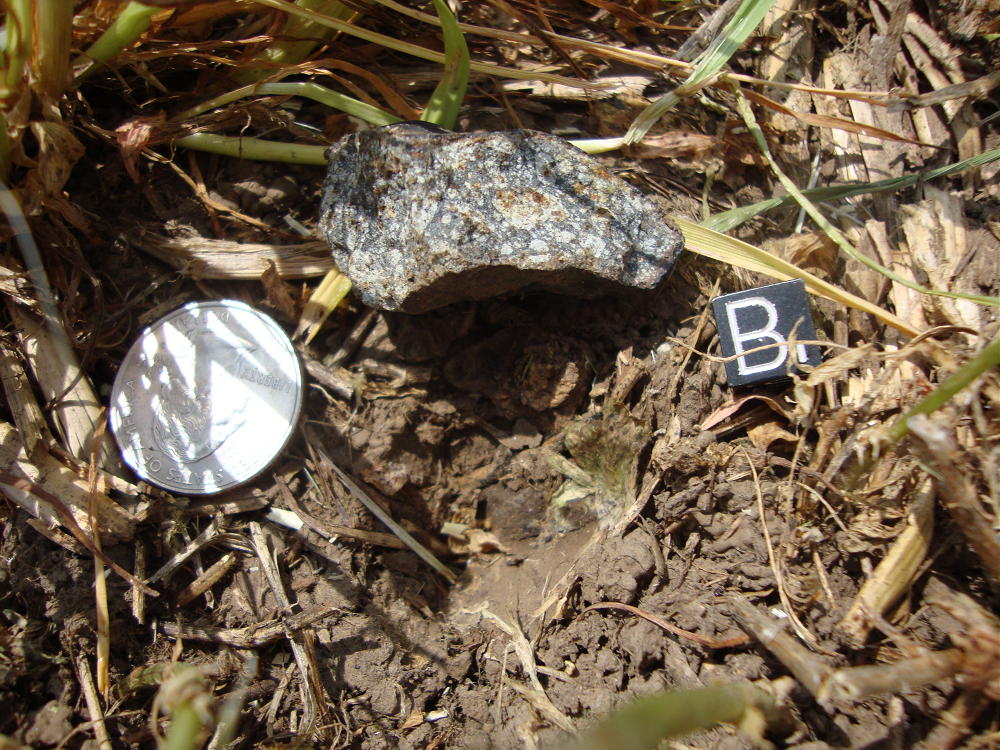
In this image I've rotated the find ~90 degrees in order to show the bottom-side ("B"-side) of the meteorite. This view shows a broken surface that clearly displays the brecciated fabric of this chondrite. Also visible directly below the meteorite, is the depression in the ground, probably made when the tractor ran over this stone!
I had been hunting for more than two weeks, and on the last day before I was to depart for home, I finally found one.
Then a thought came to me. I remembered that a week earlier (and more than a week into my search effort), while walking all day down one corn row after another, I fantasized what I would do if I were to eventually find a Wisconsin meteorite. I imagined myself whooping it up so loud that every farmer and cow in the township would have to look in the direction of my boisterous celebration to wonder what happened. But now a week later, there I stood, emotionless, and looking down at my find and thinking to myself, "That wasn't so hard. Why did it take me so long?"
In retrospect, I suppose that I would have been more jubulient if making this find would have resulted in extending the strewn field or resulted in opening-up a new cluster of finds. But when I looked around, I could see that my find wasn't very far from where other earlier finds had been made, as well as, my find was right on the consensus trend-line and right in the middle of the strewn field. So, I guess that's the reason I acted unemotional; I guess I save my celebrations for my "cold finds".
Still, I felt deservedly satisfied with my find. And since then, I know that very few [Mifflin] Wisconsin meteorite finds have been made. And with time, there will be even fewer found.
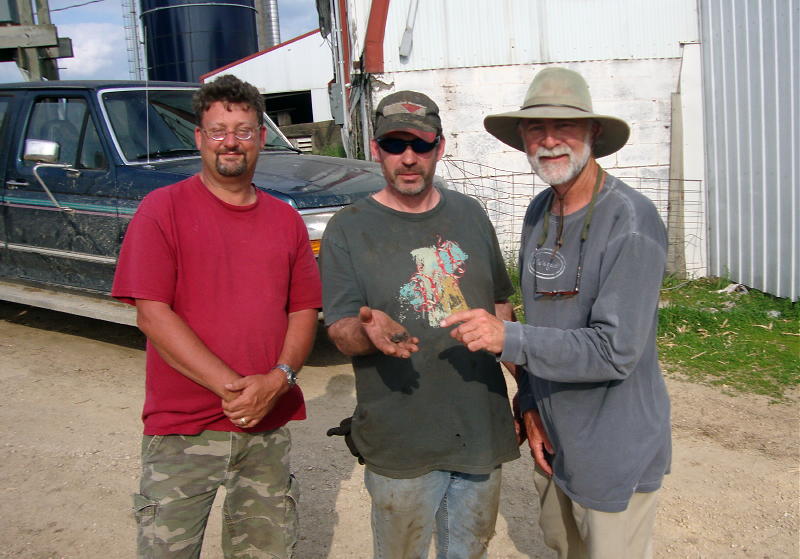
Greg Stanley and I presenting the find to the landowner.
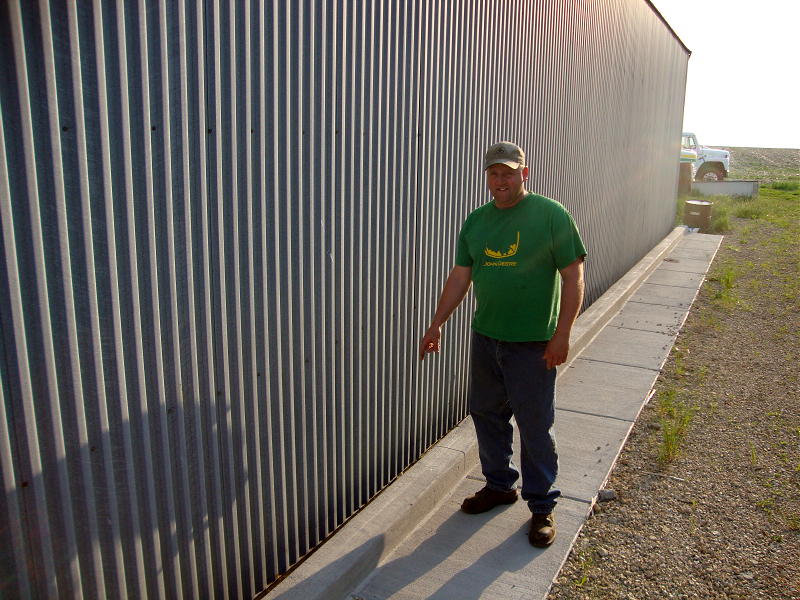
Farmer Wade points to where he found his meteorite after he heard it hit his "shed".

End of the day "tailgate party"!
What follows is from the Archives of the Meteorite-List and is a reprint of my post reporting on my May 2010 trip to Wisconsin:
"Wisconsin Meteorite Trip Report" Hello List, This post reports on my Wisconsin Meteorite search efforts from earlier this month. The focus of this effort was an attempt to extend the “known” strewn field in both directions – east and west, using images of NOAA-NWS Doppler radar weather data that were generated by Rob Matson. Some of these images can be viewed on my webpage, here:https://meteorite-recovery.tripod.com/2010/may10.htm
These same images and data were supplied by Rob to Sonny Clary, as well, and as it turns out, even though we were hunting independently, we were conducting our searches at the same time and in the same general area, but on neighboring farms. Sonny returned home before I departed the strewn field and has already posted his very well-written “trip report”. Since many of my observations only serve to corroborate what Sonny has already reported, my report will be shorter. So for reference, here is a link to Sonny’s previous “trip report”:http://six.pairlist.net/pipermail/meteorite-list/2010-May/064913.html
Started my search in Lafayette County in a township known as Willow Springs by contacting eyewitnesses and farmers in order to obtain permission to walk their property. This part of my job was made easier (inadvertently) by Sonny, who preceded me by a day and had already explained to the property owners our mission. Continued to cross paths with Sonny until we accidentally met near the courthouse in Darlington. We talked briefly, exchanging field notes and discussing hunting strategy. I had no Wisconsin finds to show him, but I did get to closely examine Brix’s find from his earlier trip. All that I had to show for my efforts, up to this point, was a sack-full of morels:https://meteorite-recovery.tripod.com/2010/wi/dsc01268morrel.jpg
It was at this point that I decided it was time to pay a visit to the other end of the strewn field. I attempted to extend the “known” strewn field (at that time) to the west of Highway 80 in an area known as the “Amish Farm”. These folk were quite friendly and very inquisitive about meteorites and meteors, as were all of the other farmers that I met. They helped me get in contact with the neighboring farmers. One farm had a particularly strong Doppler radar reflection centered over it in a satellite image. Although I hiked a lot of this area, there were many fields that were too lush with vegetation or were recently planted. Encouraged by the announcement of the location for Michael Cottingham’s 105 gram find, I now focused my search in areas to the east of Hwy 151, and with the hope that there would be a continued repeat in the pattern that I noticed in the clusters of finds from “up trend” in the strewn field. So, I selected areas to search that were 3 miles farther down the trend of the flight path, and that were located under strong Doppler radar reflections as depicted in Rob Matson’s satellite images. In this area, there were fields of alfalfa, grass, and rye starting to get cut, and I felt encouraged that, if given more time, a meteorite find could have been eventually made. But on this leg of my trip, I again made no finds and I failed to extend the strewn field. Now, I had to return to the airport at Madison to pick-up my met-hunting partner, Greg Stanley. So, the next morning with a fresh pair of eyes and legs we started our search anew. Greg’s plan was to start in the middle of the strewn field and work outwards. Prior to Greg’s arrival, I had already selected farms that were in the process of cutting-chopping-bailing grass and obtained prior-approval to hunt those fields from the farmers. Long-story-short, I finally made a find! It is a 31 gram fragment with 3 sides of fusion-crust, 2 sides of fresh-broken surface, and 1 side that has faint evidence of a short-duration, secondary f-c melting event. It was found in a freshly cut hay field right in the middle of the strewn field and right on the generally-accepted trend line. And, of course, I waited until my last day (before Greg and I were to depart for home) to make our one and only find from this fall. My track-record for being a first-rate procrastinator remains unblemished.https://meteorite-recovery.tripod.com/2010/wi/dsc01425find-b.jpg
Before departing, I invited Keith Jenkerson (who, along with Dana, were staying at a neighboring farm) to use his metal-detector and try his luck at finding the missing pieces to my fragment at the find location. He was unable to detect any of the missing pieces, but for his effort he was rewarded – he made his 2nd WI find [~15g] while walking back to meet Dana.https://meteorite-recovery.tripod.com/2010/wi/dsc01453jenkerson2.jpg
Later that last night, Greg and I gave farmer Wade a ride back to his farm and shared some beers with him at his “ground zero” shed. Then we all went over to the neighboring farm where Keith and Dana were staying, where we celebrated our good luck that day, and celebrated our good luck at making friends with such great people and in being able to share with them their new strewn field. Departure the next day was bittersweet. It would be good to get back home. But it seemed like such a waste to leave, particularly after obtaining all that hard-learned expertise, and after meeting all those farmers, and making new friends, and especially while there were new hay fields being cut! It won’t take very long for all that vegetation to grow back. The crops will quickly grow to maturity, and all the while the farmers will be continually busy driving their tractors in those fields. On Wisconsin! Bob V.
Bob's Findings:
May 2010 Article - in Meteorite-Times.Com -
"What Made the Recovery of Meteorites from the 4/14/2010 Fall in Wisconsin such a Rapid and Timely Success? " -
I feel that it was the high-quality of the NWS Doppler-radar with its very distinctive trace of the fireball (which was readily available to the general public) that was the impetus to getting the meteorite hunters so quickly into the [strewn] field.
Discover Magazine:
Huge fireball over Wisconsin! | Bad Astronomy | - Apr 14, 2010 ... Rob Matson Says: April 16th, 2010 at 12:25 am ... The story doesn't say where the find was made, but my educated guess (based on Doppler radar imagery) is that it was recovered ...
Shawn Alan:
Meteorite Fall Wisconsin - in MeteoritesRock.com -
The interesting facts, video news reports, newspaper etc.
Bob's Findings:
March 2009 Article - in Meteorite-Times.Com -
"What Made the Recovery of Meteorites at West, TX such a Success?" - Comparison of some recent bolide events.
NEXRAD:
Next-Generation Radar - in Wikipedia -
is a network of 159 high-resolution Doppler weather radars operated by the National Weather Service, an agency of the National Oceanic and Atmospheric Administration (NOAA) within the United States Department of Commerce.
FBWG:
Fireball Working Group - The purpose of this group is to exchange data regarding fireball events and to provide a venue for experts and novices to assist field investigators in collecting and analyzing reports from whatever traditional or non-traditional sources there maybe.
Google Search Results for:
Mifflin Wisconsin Meteorite Fall - Wisconsin News -
Midwest meteor named Mifflin after Wis. township...
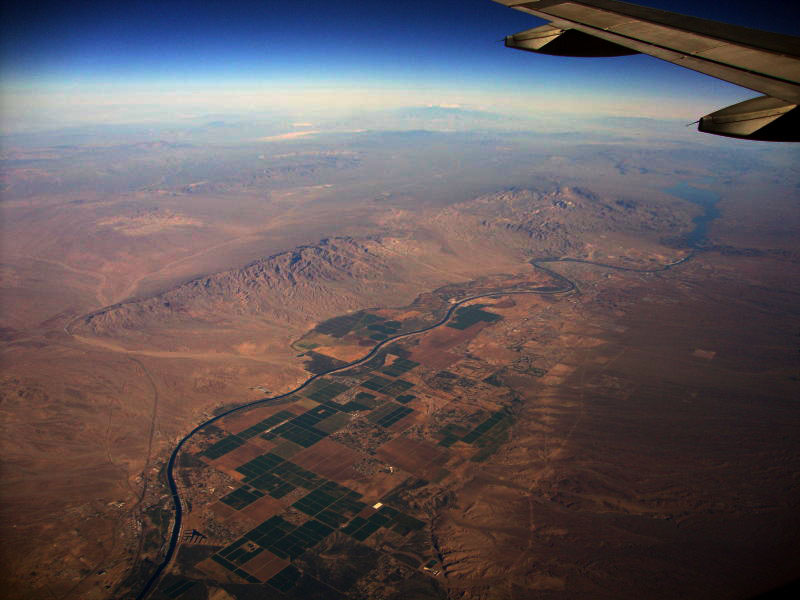
An early morning flight out of San Diego to Wisconsin had a flight path over Needles, CA and Laughlin, NV. In the early morning sunlight Ivanpah Dry Lake is barely visible.
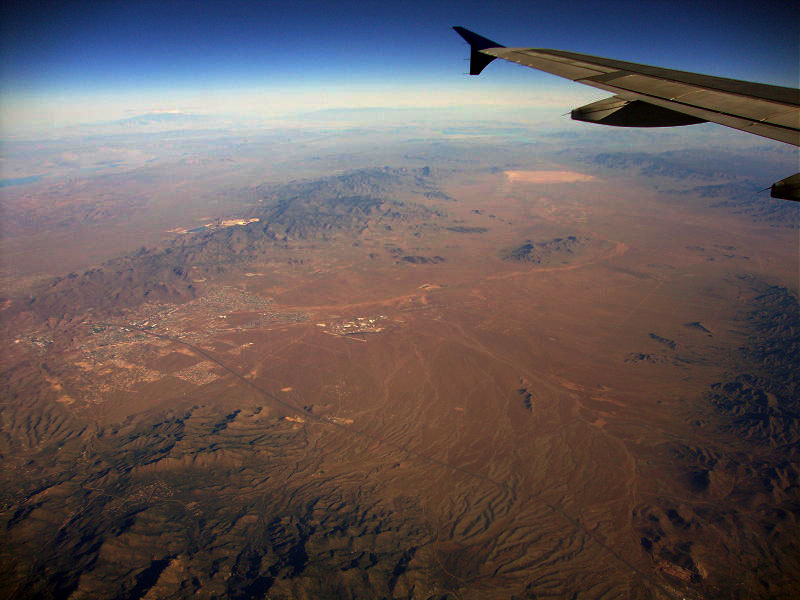
A little later the flight path went over Kingman, AZ. In the distance can be seen Red (Dry) Lake.
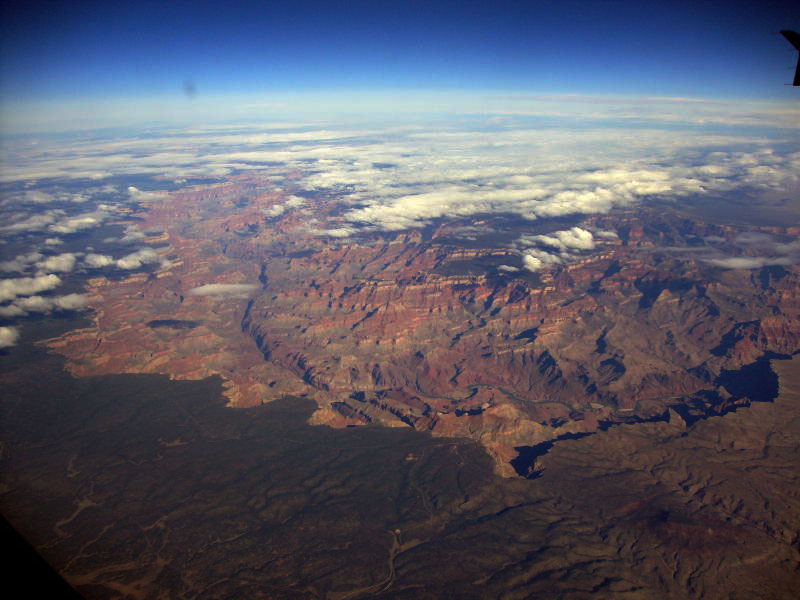
The Grand Canyon in early morning sunlight.
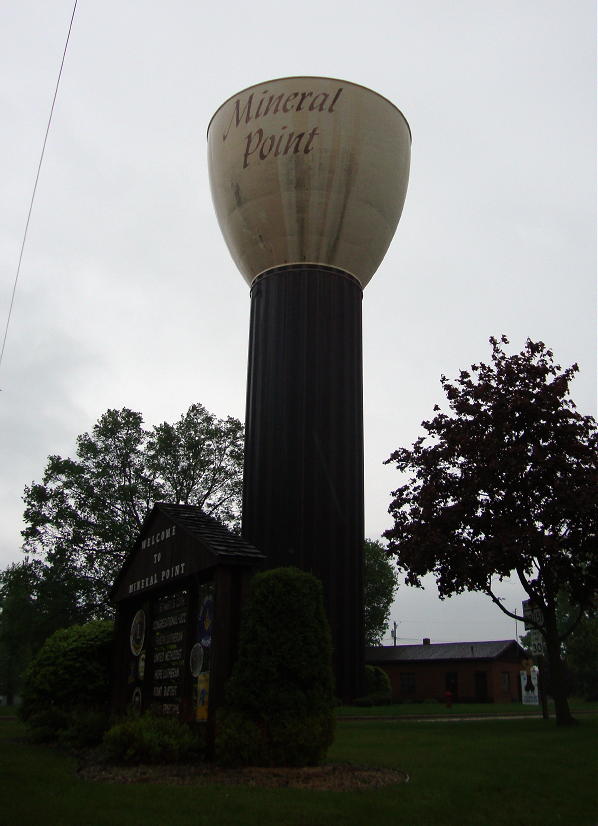
Mineral Point, WI in the early evening rain.

Lafayette County, Wisconsin in the early morning rain.

Fungus growing on a tree in Lafayette County, Wisconsin.

A "blonde" morel growing under that same tree in Lafayette County, Wisconsin.
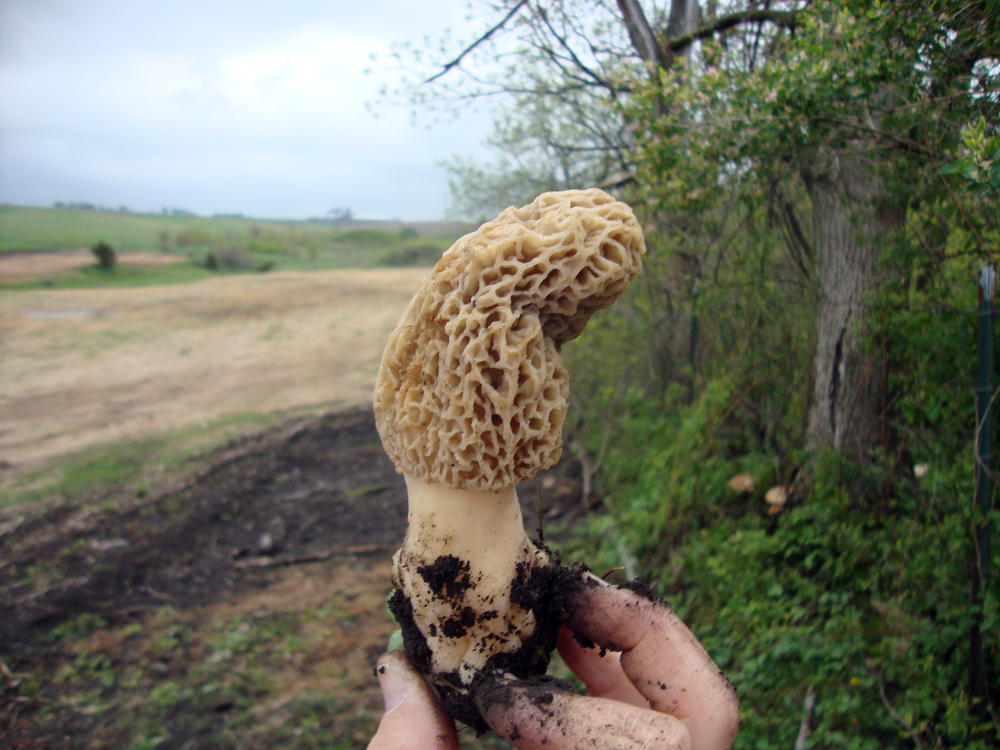
Morchella esculenta - Common Yellow Morel (but a very large one).
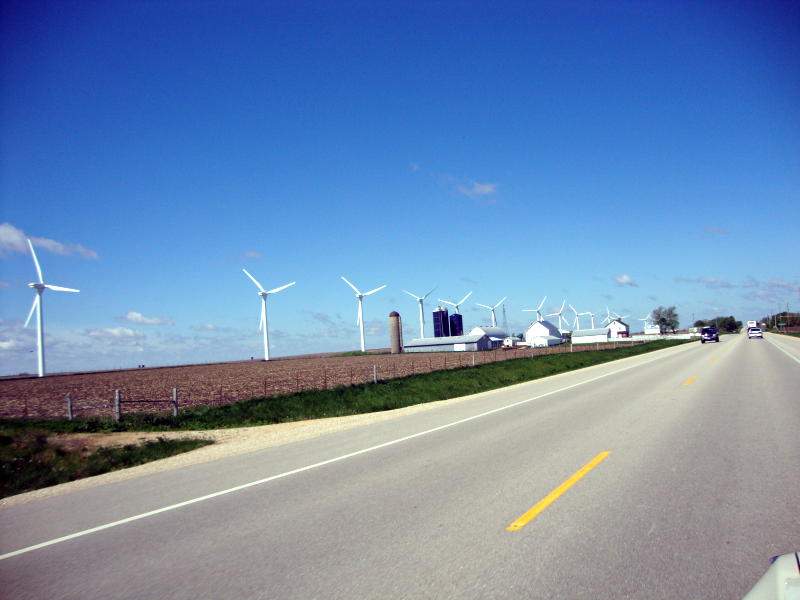
The "Wind Farm" near Montfort in Iowa County, Wisconsin.
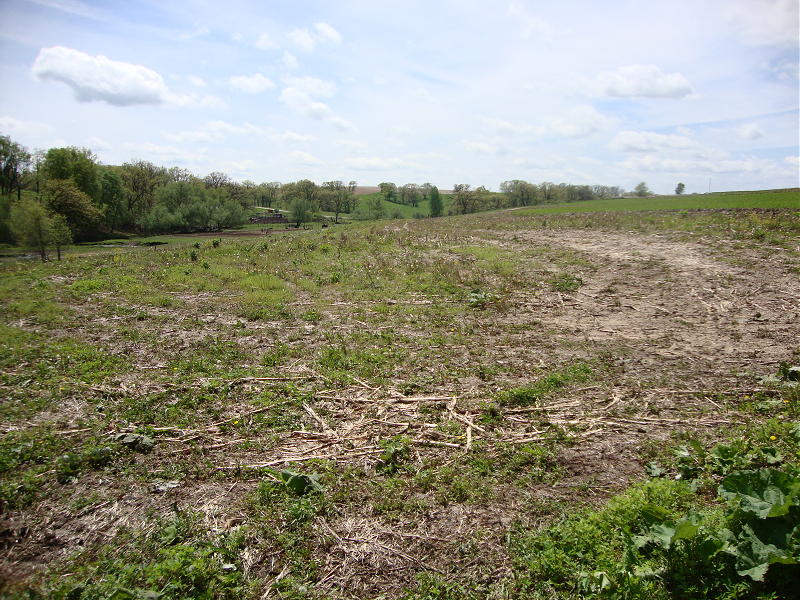
Lush growth in a corn-stubble field in Grant County, Wisconsin.

A mushroom growing on corn-stubble on a farm in Grant County, Wisconsin.
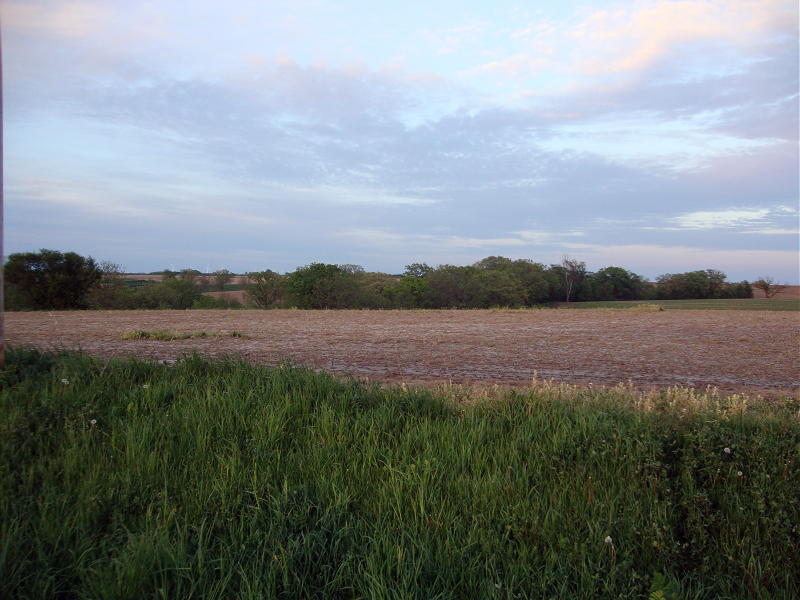
Low-angle evening sunlight illuminates a field on a farm in Grant County, Wisconsin.
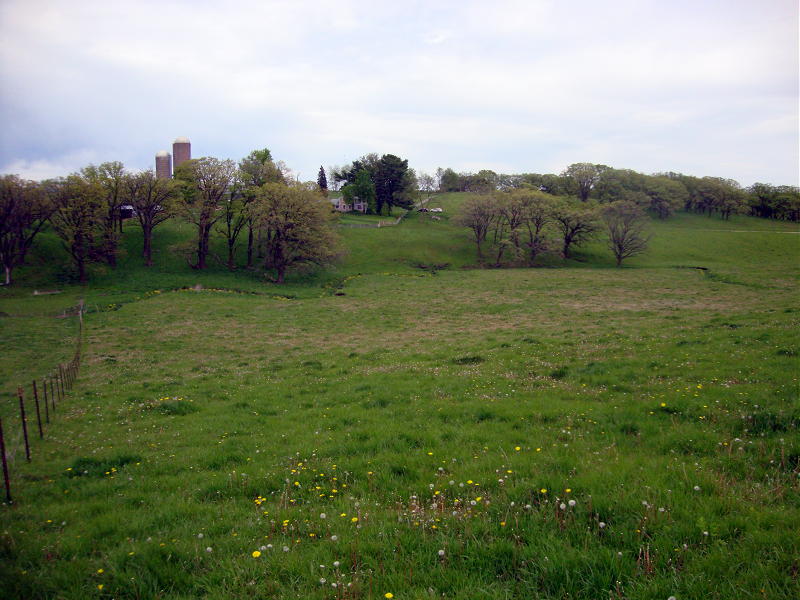
Perfect daylight to search a pasture on a farm near Linden in Iowa County, Wisconsin.
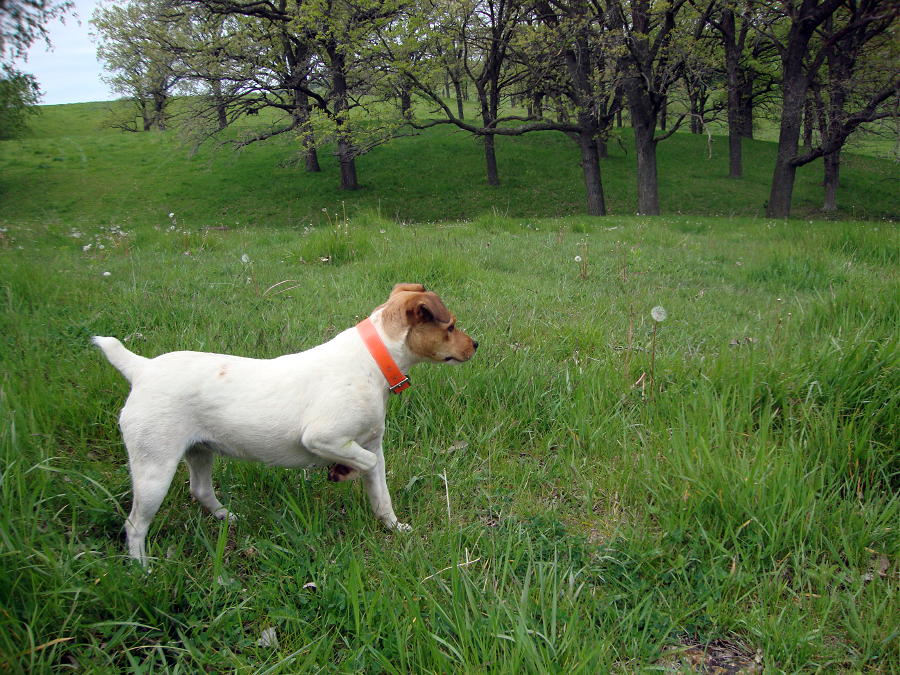
The farmer's dog accompanied me the entire day as I hiked all of the pasteur lands. Unfortunately, the dog wasn't pointing at a meteorite.
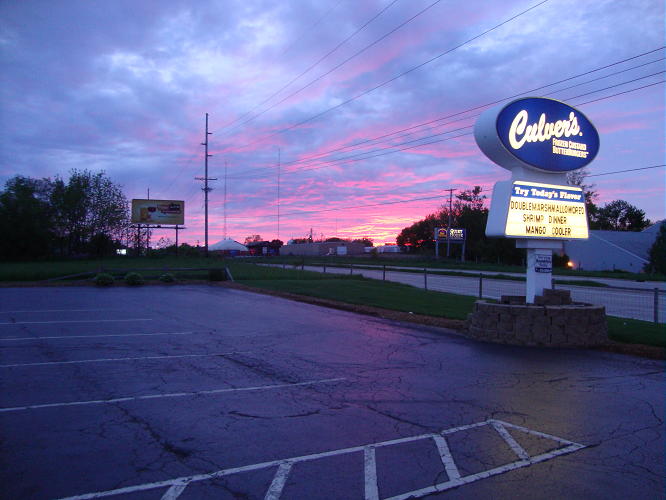
A must stop for custard in Dodgeville, WI.
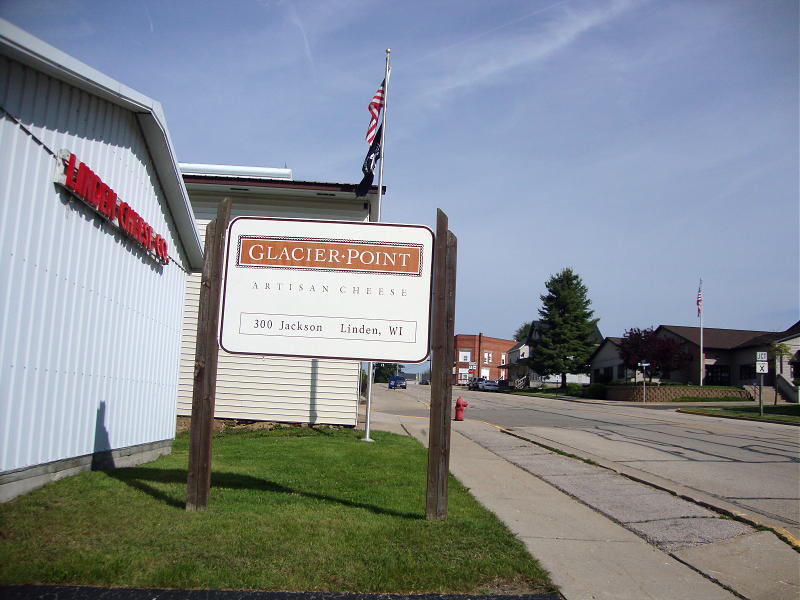
This small cheese company in Linden, WI makes a lot of cheese for the Olive Garden Restaurant.
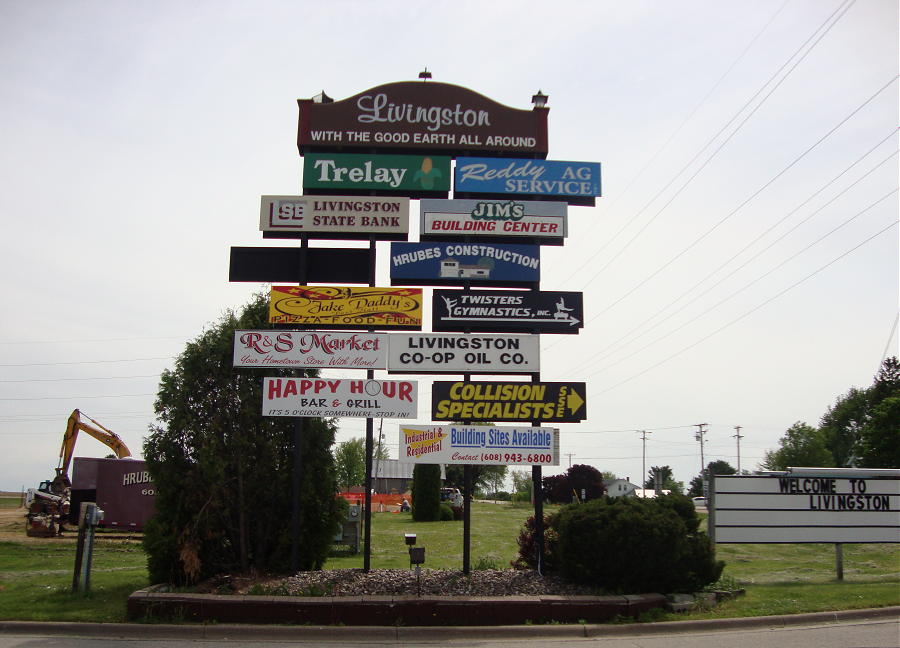
The Happy Hour Bar & Grill has great midday sandwiches.

This was a favorite lunchtime gathering spot for meteorite hunters in Livingston, WI.
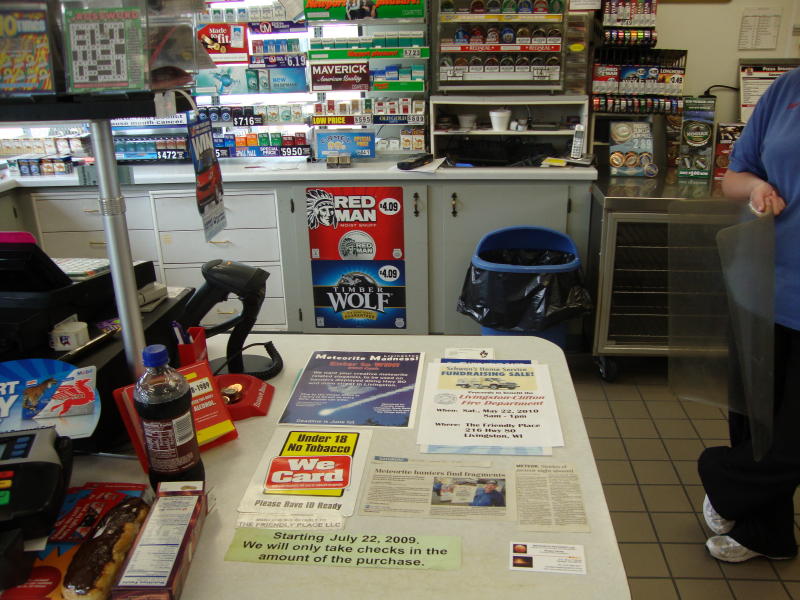
Check-out the check-out-counter at the Livingston Mobil gas station.
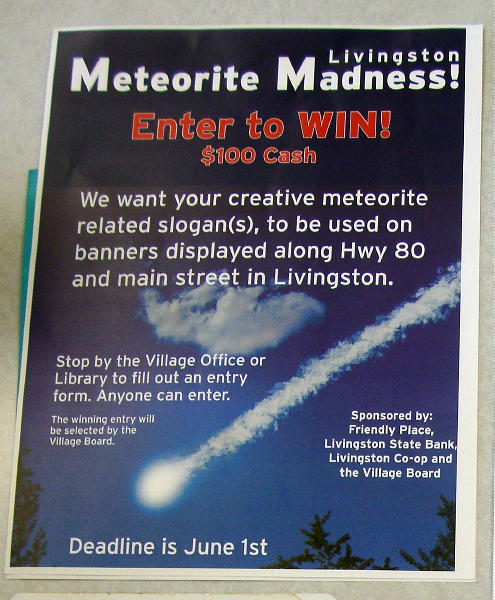
Anybody know what was the winning slogan?
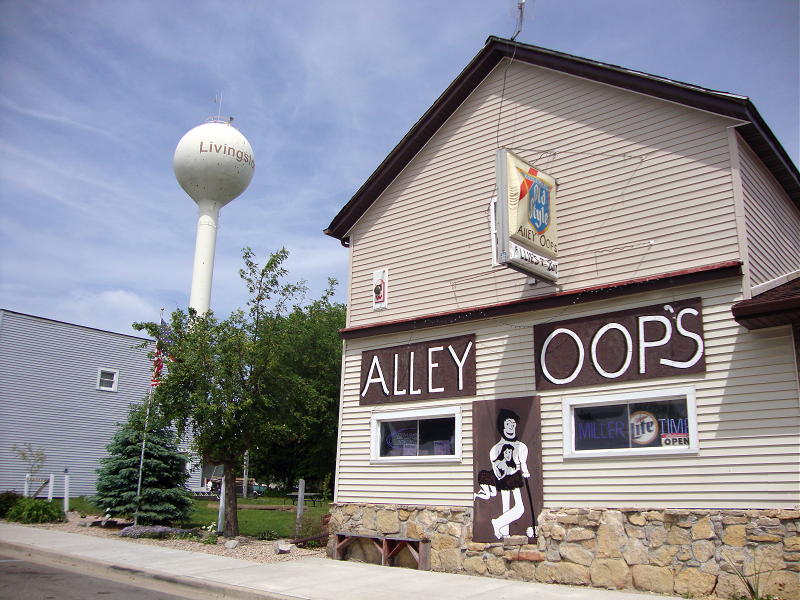
Main Street in Livingston, Wisconsin.
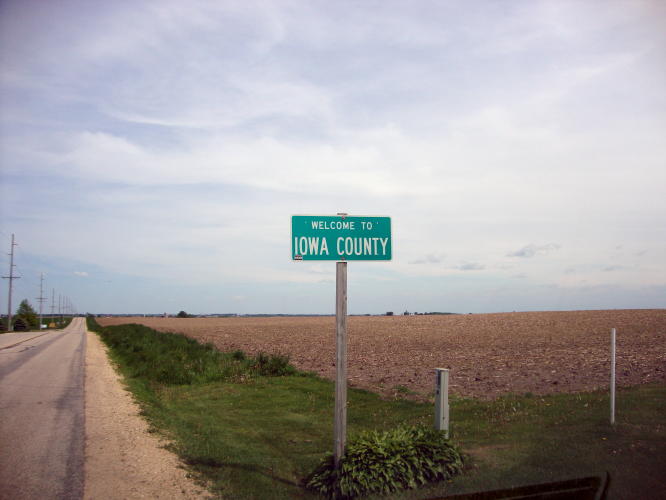
Road sign just east of Livingston on Rt. X?
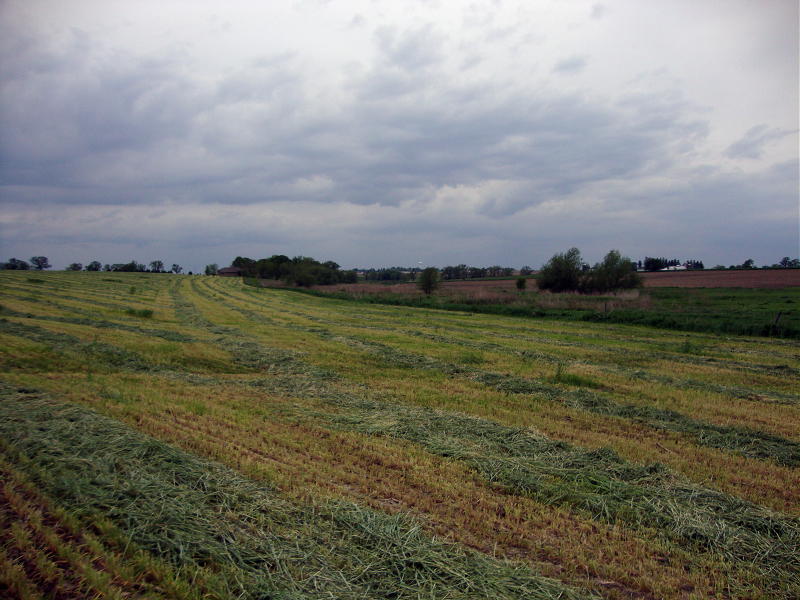
This is how "rye grass" is grown and cut in Iowa County, WI. This field may look easy to hunt, but the stubble is too tall and it hides small objects very well. Trust me.
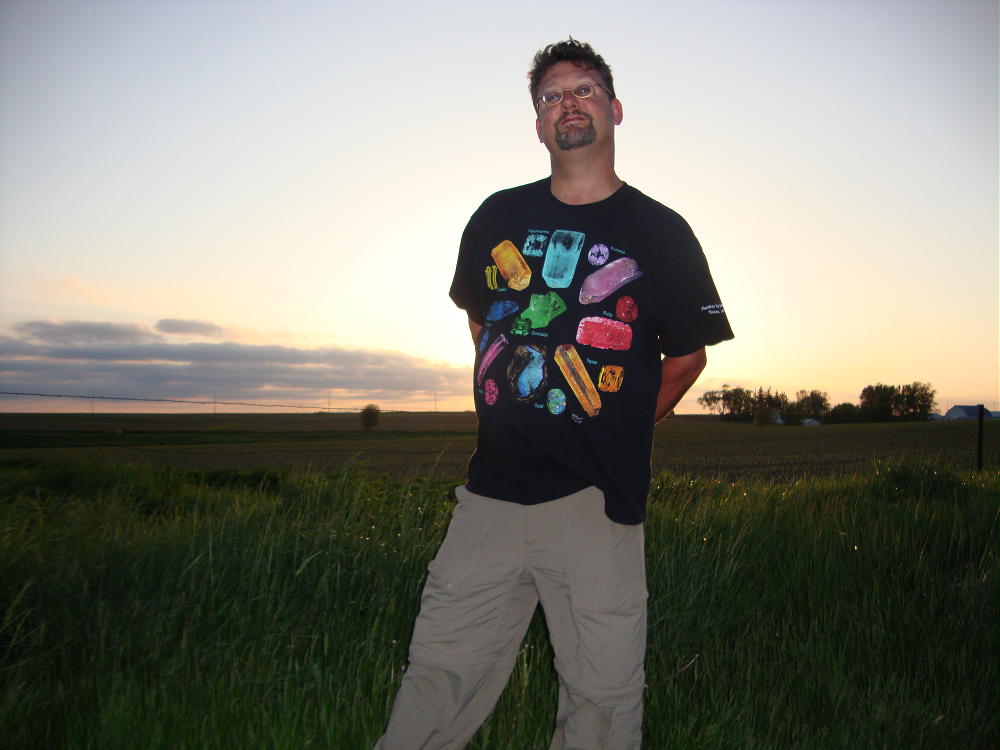
Greg Stanley, at the end of a very long day of meteorite hunting.
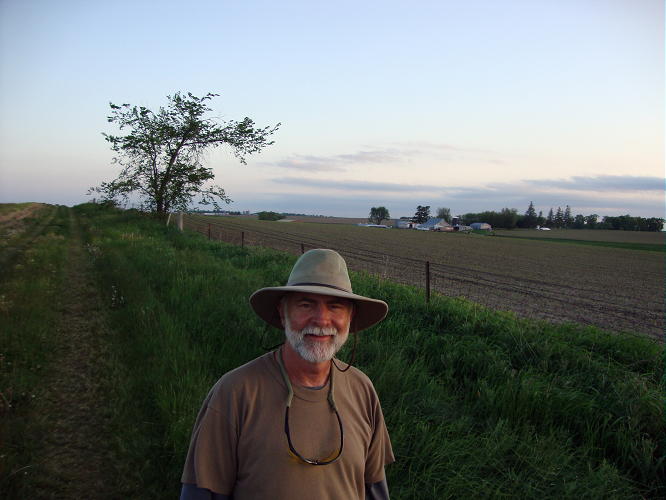
Greg's turn to take my picture.

Dana and Keith Jenkerson, just before Keith found his 2nd stone.
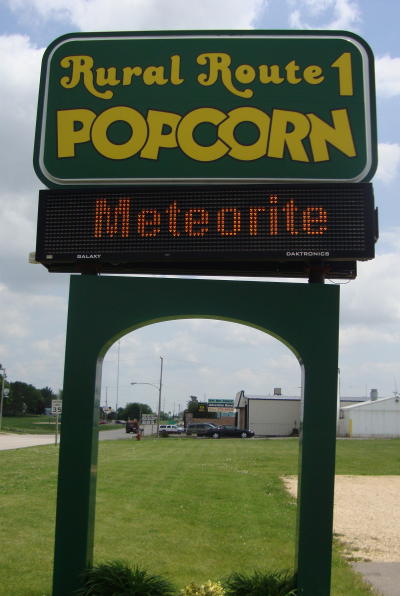

Meteorite [was] On Display at the Popcorn Factory in Montfort, WI.
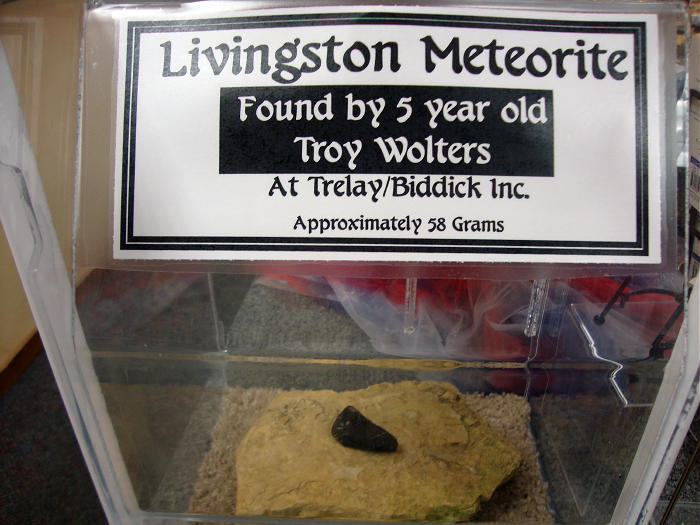
Temporay Display at the Popcorn Factory.
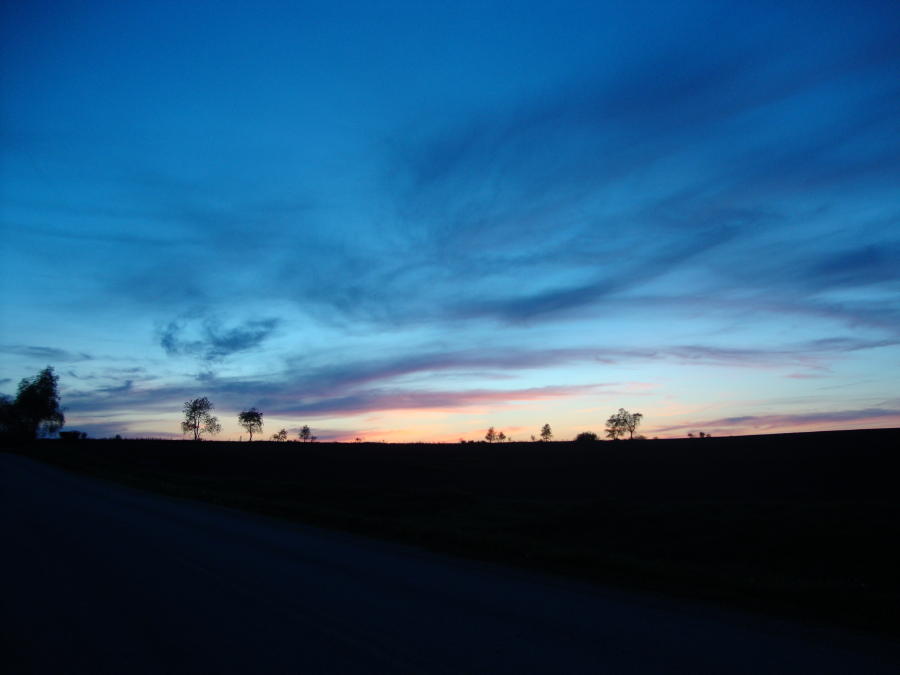
Sunset brings a great end to a wonderful trip.
For for more information, please contact me by email:
Bolide*chaser
